- Hot on the heels of FXpansion's Maul comes iZotope's Trash 2 plug-in, offering a range of distortion and saturation treatments through a flexible effects chain. As its name suggests, this is the second incarnation of Trash, though I'll treat the plug-in as new to explain its signal flow and capabilities. If you're an existing user, it's worth reading on anyway, as you'll find increased capability in every module. Additionally, Trash 2 is now capable of operating within 64- as well as 32-bit hosts.
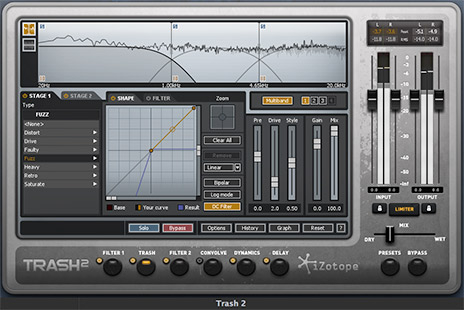 Trash 2 offers six independent modules through which your audio becomes progressively mangled—Filter 1, Trash, Filter 2, Convolve, Dynamics and Delay. Each comes with its own power LED, so the signal path is yours to construct. Though there's no way to change their order, Trash 2 is flexible enough that you're unlikely to want to.
As a case in point, let's have a look inside Filter 1. It looks like an EQ, with six fully moveable bands to create cuts and boosts where you like. But "EQ" barely scratches the surface of its capabilities. Each band can be configured to a wide range of options, including "wrong" ones. You can choose a filter type from drop-down menus in each band, like low-pass, band-pass, high-pass, peak and shelf. However, if you decide you want the fourth band to band-pass, the fifth to low-pass and the second to provide a high shelf, no problem. Large amounts of cut or boost can be applied to each band, and envelope and LFO modules provide modulation. The latter has a range of shapes that can run freely or sync to tempo. For a plug-in that sells itself as offering distortion and saturation, Trash clearly goes much further.
Trash 2 offers six independent modules through which your audio becomes progressively mangled—Filter 1, Trash, Filter 2, Convolve, Dynamics and Delay. Each comes with its own power LED, so the signal path is yours to construct. Though there's no way to change their order, Trash 2 is flexible enough that you're unlikely to want to.
As a case in point, let's have a look inside Filter 1. It looks like an EQ, with six fully moveable bands to create cuts and boosts where you like. But "EQ" barely scratches the surface of its capabilities. Each band can be configured to a wide range of options, including "wrong" ones. You can choose a filter type from drop-down menus in each band, like low-pass, band-pass, high-pass, peak and shelf. However, if you decide you want the fourth band to band-pass, the fifth to low-pass and the second to provide a high shelf, no problem. Large amounts of cut or boost can be applied to each band, and envelope and LFO modules provide modulation. The latter has a range of shapes that can run freely or sync to tempo. For a plug-in that sells itself as offering distortion and saturation, Trash clearly goes much further.
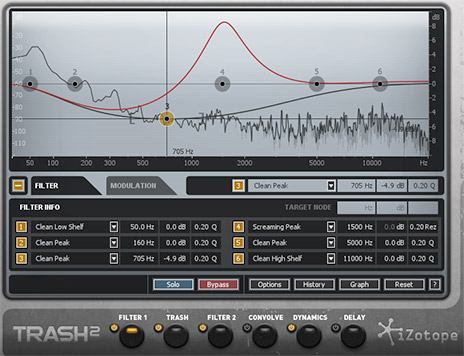 Though you can run Filter 1 in isolation, the party doesn't really get started until you've enabled the Trash module. Despite representing only one part of Trash 2's chain of effects, it actually contains twin stages of distortion and saturation (which, again, can be independently enabled). Each category of effect here—Distort, Drive, Faulty, Fuzz, Heavy, Retro and Saturate—is a treasure-trove, and this sub-categorization is hugely useful for quickly tracking down treatments. Stage one feeds into stage two, where you can select a second distortion module, and then dedicated waveshaping and filter modules take over. The waveshaper sums the distortion effects and provides timbral control via six waveshapes. Finally, the filter (independent from the twin filter modules) offers two-band enhancement or attenuation.
This module is impressive enough in its own right, but what I've described so far are Trash's capabilities in single-band mode. In multi-band mode, the signal splits into as many as four user-defined frequency bands, with each of the features described above offered per band. Thus, you can configure two stages of distortion or saturation for the low-end, two for the mids and two more for the top, whilst also providing waveshaping and filtering for each. Comprehensive, independent level control is provided for each stage, too, with dry/wet mix sliders for each band in addition to a global one.
Though you can run Filter 1 in isolation, the party doesn't really get started until you've enabled the Trash module. Despite representing only one part of Trash 2's chain of effects, it actually contains twin stages of distortion and saturation (which, again, can be independently enabled). Each category of effect here—Distort, Drive, Faulty, Fuzz, Heavy, Retro and Saturate—is a treasure-trove, and this sub-categorization is hugely useful for quickly tracking down treatments. Stage one feeds into stage two, where you can select a second distortion module, and then dedicated waveshaping and filter modules take over. The waveshaper sums the distortion effects and provides timbral control via six waveshapes. Finally, the filter (independent from the twin filter modules) offers two-band enhancement or attenuation.
This module is impressive enough in its own right, but what I've described so far are Trash's capabilities in single-band mode. In multi-band mode, the signal splits into as many as four user-defined frequency bands, with each of the features described above offered per band. Thus, you can configure two stages of distortion or saturation for the low-end, two for the mids and two more for the top, whilst also providing waveshaping and filtering for each. Comprehensive, independent level control is provided for each stage, too, with dry/wet mix sliders for each band in addition to a global one.
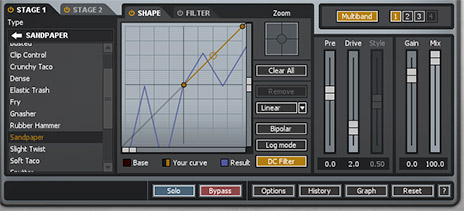 Filter 2 provides the same capability as Filter 1. If you're wondering why a second identical module is included, remember that the sound you've made is likely to have changed wildly post-Trash. Thus, it's great to have comprehensive frequency control to rein in anything that's gotten a little wild.
The Convolve module brings convolution effects shaping to your treatments, allowing you to pass your sound through a range of cabinets, speakers and more. Once you've chosen one, you can then select a dynamic, condenser or ribbon microphone to suit it. Sliders provide control over separation and width effects. You can also use your own impulse responses, though these must be in AIFF or WAV format and have a length of 44,100 samples. If longer sounds are loaded, Trash will trim them.
Filter 2 provides the same capability as Filter 1. If you're wondering why a second identical module is included, remember that the sound you've made is likely to have changed wildly post-Trash. Thus, it's great to have comprehensive frequency control to rein in anything that's gotten a little wild.
The Convolve module brings convolution effects shaping to your treatments, allowing you to pass your sound through a range of cabinets, speakers and more. Once you've chosen one, you can then select a dynamic, condenser or ribbon microphone to suit it. Sliders provide control over separation and width effects. You can also use your own impulse responses, though these must be in AIFF or WAV format and have a length of 44,100 samples. If longer sounds are loaded, Trash will trim them.
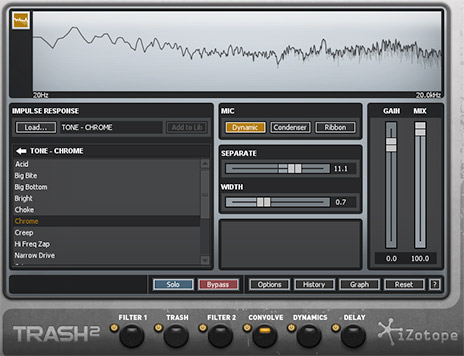 The Dynamics module comes next, and like Trash, it operates in single- or multi-band mode. In single-band mode, you're greeted with separate compressor and gate sections, with a compression graph you can scale to taste. At the top, you'll see a waveform display of the incoming audio with the processed sound represented on top. Compression and gating effects appear as a series of red lines dropping in level below the threshold point. The display is nicely designed and provides an invaluable monitor for your changes. Multi-band mode is similarly impressive, and its "monitor all" option reminds me a little of Logic's Multipressor plug-in. All four bands are configurable with threshold, ratio, attack and release settings, with real-time visual monitoring of gain reduction for all bands at once. As ever, remember the flexibility here: if you lack a native multi-band compressor, there's nothing to stop you using this as an effect by itself.
The Dynamics module comes next, and like Trash, it operates in single- or multi-band mode. In single-band mode, you're greeted with separate compressor and gate sections, with a compression graph you can scale to taste. At the top, you'll see a waveform display of the incoming audio with the processed sound represented on top. Compression and gating effects appear as a series of red lines dropping in level below the threshold point. The display is nicely designed and provides an invaluable monitor for your changes. Multi-band mode is similarly impressive, and its "monitor all" option reminds me a little of Logic's Multipressor plug-in. All four bands are configurable with threshold, ratio, attack and release settings, with real-time visual monitoring of gain reduction for all bands at once. As ever, remember the flexibility here: if you lack a native multi-band compressor, there's nothing to stop you using this as an effect by itself.
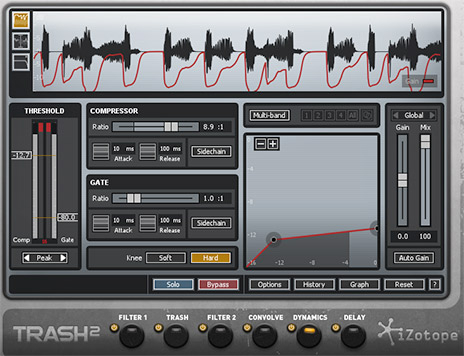 Last but not least, the Delay module offers six delay types and the choice of the frequency range over which they'll be applied. You'll also find delay speed (free or synced), feedback, Trash amount, stereo width and dry/wet sliders, so configuring an echo to match your audio is a joy.
Last but not least, the Delay module offers six delay types and the choice of the frequency range over which they'll be applied. You'll also find delay speed (free or synced), feedback, Trash amount, stereo width and dry/wet sliders, so configuring an echo to match your audio is a joy.
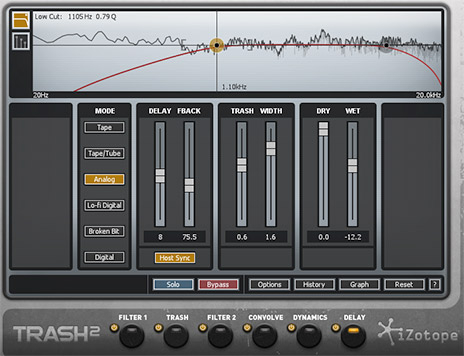 Despite the raft of new starting points developed for Trash's relaunch, you're guaranteed to kick the presets in favor of designing your own solutions. As the results you'll hear depend so heavily on the input and output levels you set—quite aside from the capabilities of each effect—you'll have more joy building your own solutions than hoping a preset will suffice.
Despite the raft of new starting points developed for Trash's relaunch, you're guaranteed to kick the presets in favor of designing your own solutions. As the results you'll hear depend so heavily on the input and output levels you set—quite aside from the capabilities of each effect—you'll have more joy building your own solutions than hoping a preset will suffice.
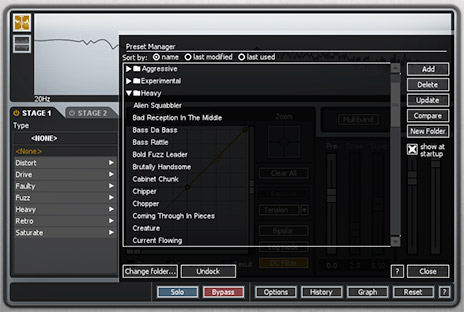 Trash 2 isn't cheap, and some Trash 1 users have riled at the $100 upgrade expense. Set against the price of a processor like Maul, Trash 2 does seem a touch pricey. But again, do bear in mind its flexibility: as you can bypass all but one of Trash 2's modules, it's possible to use this plug-in as more than a distortion/saturation module. After all, you could employ the Dynamics module as a multi-band compressor for mastering, the Delay module to provide a retro tape delay effect or the Convolve module as an auxiliary reverb. Taking this into account, I can certainly understand iZotope's price point. Capable of subtle signal finessing, destructive mayhem and everything in between, Trash 2 is comprehensive and compelling.
Ratings:
Cost: 3.5/5
Versatility: 4.5/5
Sound: 4.5/5
Ease of use: 3.5/5
Trash 2 isn't cheap, and some Trash 1 users have riled at the $100 upgrade expense. Set against the price of a processor like Maul, Trash 2 does seem a touch pricey. But again, do bear in mind its flexibility: as you can bypass all but one of Trash 2's modules, it's possible to use this plug-in as more than a distortion/saturation module. After all, you could employ the Dynamics module as a multi-band compressor for mastering, the Delay module to provide a retro tape delay effect or the Convolve module as an auxiliary reverb. Taking this into account, I can certainly understand iZotope's price point. Capable of subtle signal finessing, destructive mayhem and everything in between, Trash 2 is comprehensive and compelling.
Ratings:
Cost: 3.5/5
Versatility: 4.5/5
Sound: 4.5/5
Ease of use: 3.5/5
 Trash 2 offers six independent modules through which your audio becomes progressively mangled—Filter 1, Trash, Filter 2, Convolve, Dynamics and Delay. Each comes with its own power LED, so the signal path is yours to construct. Though there's no way to change their order, Trash 2 is flexible enough that you're unlikely to want to.
As a case in point, let's have a look inside Filter 1. It looks like an EQ, with six fully moveable bands to create cuts and boosts where you like. But "EQ" barely scratches the surface of its capabilities. Each band can be configured to a wide range of options, including "wrong" ones. You can choose a filter type from drop-down menus in each band, like low-pass, band-pass, high-pass, peak and shelf. However, if you decide you want the fourth band to band-pass, the fifth to low-pass and the second to provide a high shelf, no problem. Large amounts of cut or boost can be applied to each band, and envelope and LFO modules provide modulation. The latter has a range of shapes that can run freely or sync to tempo. For a plug-in that sells itself as offering distortion and saturation, Trash clearly goes much further.
Trash 2 offers six independent modules through which your audio becomes progressively mangled—Filter 1, Trash, Filter 2, Convolve, Dynamics and Delay. Each comes with its own power LED, so the signal path is yours to construct. Though there's no way to change their order, Trash 2 is flexible enough that you're unlikely to want to.
As a case in point, let's have a look inside Filter 1. It looks like an EQ, with six fully moveable bands to create cuts and boosts where you like. But "EQ" barely scratches the surface of its capabilities. Each band can be configured to a wide range of options, including "wrong" ones. You can choose a filter type from drop-down menus in each band, like low-pass, band-pass, high-pass, peak and shelf. However, if you decide you want the fourth band to band-pass, the fifth to low-pass and the second to provide a high shelf, no problem. Large amounts of cut or boost can be applied to each band, and envelope and LFO modules provide modulation. The latter has a range of shapes that can run freely or sync to tempo. For a plug-in that sells itself as offering distortion and saturation, Trash clearly goes much further.
 Though you can run Filter 1 in isolation, the party doesn't really get started until you've enabled the Trash module. Despite representing only one part of Trash 2's chain of effects, it actually contains twin stages of distortion and saturation (which, again, can be independently enabled). Each category of effect here—Distort, Drive, Faulty, Fuzz, Heavy, Retro and Saturate—is a treasure-trove, and this sub-categorization is hugely useful for quickly tracking down treatments. Stage one feeds into stage two, where you can select a second distortion module, and then dedicated waveshaping and filter modules take over. The waveshaper sums the distortion effects and provides timbral control via six waveshapes. Finally, the filter (independent from the twin filter modules) offers two-band enhancement or attenuation.
This module is impressive enough in its own right, but what I've described so far are Trash's capabilities in single-band mode. In multi-band mode, the signal splits into as many as four user-defined frequency bands, with each of the features described above offered per band. Thus, you can configure two stages of distortion or saturation for the low-end, two for the mids and two more for the top, whilst also providing waveshaping and filtering for each. Comprehensive, independent level control is provided for each stage, too, with dry/wet mix sliders for each band in addition to a global one.
Though you can run Filter 1 in isolation, the party doesn't really get started until you've enabled the Trash module. Despite representing only one part of Trash 2's chain of effects, it actually contains twin stages of distortion and saturation (which, again, can be independently enabled). Each category of effect here—Distort, Drive, Faulty, Fuzz, Heavy, Retro and Saturate—is a treasure-trove, and this sub-categorization is hugely useful for quickly tracking down treatments. Stage one feeds into stage two, where you can select a second distortion module, and then dedicated waveshaping and filter modules take over. The waveshaper sums the distortion effects and provides timbral control via six waveshapes. Finally, the filter (independent from the twin filter modules) offers two-band enhancement or attenuation.
This module is impressive enough in its own right, but what I've described so far are Trash's capabilities in single-band mode. In multi-band mode, the signal splits into as many as four user-defined frequency bands, with each of the features described above offered per band. Thus, you can configure two stages of distortion or saturation for the low-end, two for the mids and two more for the top, whilst also providing waveshaping and filtering for each. Comprehensive, independent level control is provided for each stage, too, with dry/wet mix sliders for each band in addition to a global one.
 Filter 2 provides the same capability as Filter 1. If you're wondering why a second identical module is included, remember that the sound you've made is likely to have changed wildly post-Trash. Thus, it's great to have comprehensive frequency control to rein in anything that's gotten a little wild.
The Convolve module brings convolution effects shaping to your treatments, allowing you to pass your sound through a range of cabinets, speakers and more. Once you've chosen one, you can then select a dynamic, condenser or ribbon microphone to suit it. Sliders provide control over separation and width effects. You can also use your own impulse responses, though these must be in AIFF or WAV format and have a length of 44,100 samples. If longer sounds are loaded, Trash will trim them.
Filter 2 provides the same capability as Filter 1. If you're wondering why a second identical module is included, remember that the sound you've made is likely to have changed wildly post-Trash. Thus, it's great to have comprehensive frequency control to rein in anything that's gotten a little wild.
The Convolve module brings convolution effects shaping to your treatments, allowing you to pass your sound through a range of cabinets, speakers and more. Once you've chosen one, you can then select a dynamic, condenser or ribbon microphone to suit it. Sliders provide control over separation and width effects. You can also use your own impulse responses, though these must be in AIFF or WAV format and have a length of 44,100 samples. If longer sounds are loaded, Trash will trim them.
 The Dynamics module comes next, and like Trash, it operates in single- or multi-band mode. In single-band mode, you're greeted with separate compressor and gate sections, with a compression graph you can scale to taste. At the top, you'll see a waveform display of the incoming audio with the processed sound represented on top. Compression and gating effects appear as a series of red lines dropping in level below the threshold point. The display is nicely designed and provides an invaluable monitor for your changes. Multi-band mode is similarly impressive, and its "monitor all" option reminds me a little of Logic's Multipressor plug-in. All four bands are configurable with threshold, ratio, attack and release settings, with real-time visual monitoring of gain reduction for all bands at once. As ever, remember the flexibility here: if you lack a native multi-band compressor, there's nothing to stop you using this as an effect by itself.
The Dynamics module comes next, and like Trash, it operates in single- or multi-band mode. In single-band mode, you're greeted with separate compressor and gate sections, with a compression graph you can scale to taste. At the top, you'll see a waveform display of the incoming audio with the processed sound represented on top. Compression and gating effects appear as a series of red lines dropping in level below the threshold point. The display is nicely designed and provides an invaluable monitor for your changes. Multi-band mode is similarly impressive, and its "monitor all" option reminds me a little of Logic's Multipressor plug-in. All four bands are configurable with threshold, ratio, attack and release settings, with real-time visual monitoring of gain reduction for all bands at once. As ever, remember the flexibility here: if you lack a native multi-band compressor, there's nothing to stop you using this as an effect by itself.
 Last but not least, the Delay module offers six delay types and the choice of the frequency range over which they'll be applied. You'll also find delay speed (free or synced), feedback, Trash amount, stereo width and dry/wet sliders, so configuring an echo to match your audio is a joy.
Last but not least, the Delay module offers six delay types and the choice of the frequency range over which they'll be applied. You'll also find delay speed (free or synced), feedback, Trash amount, stereo width and dry/wet sliders, so configuring an echo to match your audio is a joy.
 Despite the raft of new starting points developed for Trash's relaunch, you're guaranteed to kick the presets in favor of designing your own solutions. As the results you'll hear depend so heavily on the input and output levels you set—quite aside from the capabilities of each effect—you'll have more joy building your own solutions than hoping a preset will suffice.
Despite the raft of new starting points developed for Trash's relaunch, you're guaranteed to kick the presets in favor of designing your own solutions. As the results you'll hear depend so heavily on the input and output levels you set—quite aside from the capabilities of each effect—you'll have more joy building your own solutions than hoping a preset will suffice.
 Trash 2 isn't cheap, and some Trash 1 users have riled at the $100 upgrade expense. Set against the price of a processor like Maul, Trash 2 does seem a touch pricey. But again, do bear in mind its flexibility: as you can bypass all but one of Trash 2's modules, it's possible to use this plug-in as more than a distortion/saturation module. After all, you could employ the Dynamics module as a multi-band compressor for mastering, the Delay module to provide a retro tape delay effect or the Convolve module as an auxiliary reverb. Taking this into account, I can certainly understand iZotope's price point. Capable of subtle signal finessing, destructive mayhem and everything in between, Trash 2 is comprehensive and compelling.
Ratings:
Cost: 3.5/5
Versatility: 4.5/5
Sound: 4.5/5
Ease of use: 3.5/5
Trash 2 isn't cheap, and some Trash 1 users have riled at the $100 upgrade expense. Set against the price of a processor like Maul, Trash 2 does seem a touch pricey. But again, do bear in mind its flexibility: as you can bypass all but one of Trash 2's modules, it's possible to use this plug-in as more than a distortion/saturation module. After all, you could employ the Dynamics module as a multi-band compressor for mastering, the Delay module to provide a retro tape delay effect or the Convolve module as an auxiliary reverb. Taking this into account, I can certainly understand iZotope's price point. Capable of subtle signal finessing, destructive mayhem and everything in between, Trash 2 is comprehensive and compelling.
Ratings:
Cost: 3.5/5
Versatility: 4.5/5
Sound: 4.5/5
Ease of use: 3.5/5